Comparative Study on Modulation of Synchronized Neuronal Activity by SK Channels and Na/K-ATPase
Abstract
1. Introduction
2. Results
2.1. NKA Signaling and SK-Channel Activation Suppress Synchronized Epileptiform Currents
2.2. NKA Signaling and SK-Channel Activation Inhibit Synchronized Calcium Transients in Neurons
3. Discussion
4. Materials and Methods
4.1. Primary Culture of Cortical Neurons
4.2. Recording of Postsynaptic Currents and Data Processing
4.3. Optical Detection of Calcium Transients and Image Processing
4.4. Reagents
4.5. Statistics
Author Contributions
Funding
Institutional Review Board Statement
Informed Consent Statement
Data Availability Statement
Conflicts of Interest
References
- Fattorusso, A.; Matricardi, S.; Mencaroni, E.; Dell’Isola, G.B.; Di Cara, G.; Striano, P.; Verrotti, A. The pharmacoresistant epilepsy: An overview on existent and new emerging therapies. Front. Neurol. 2021, 12, 674483. [Google Scholar] [CrossRef]
- Löscher, W.; Potschka, H.; Sisodiya, S.M.; Vezzani, A. Drug resistance in epilepsy: Clinical impact, potential mechanisms, and new innovative treatment options. Pharmacol. Rev. 2020, 72, 606–638. [Google Scholar] [CrossRef]
- Hanaya, R.; Arita, K. The new antiepileptic drugs: Their neuropharmacology and clinical indications. Neurol. Med. Chir. 2016, 56, 205–220. [Google Scholar] [CrossRef] [PubMed]
- Marvanova, M. Pharmacokinetic characteristics of antiepileptic drugs (AEDs). Ment. Health Clin. 2016, 6, 8–20. [Google Scholar] [CrossRef]
- Kosmider, K.; Kamieniak, M.; Czuczwar, S.J.; Miziak, B. Second generation of antiepileptic drugs and oxidative stress. Int. J. Mol. Sci. 2023, 24, 3873. [Google Scholar] [CrossRef] [PubMed]
- Russo, E.; Constanti, A. Topiramate hyperpolarizes and modulates the slow poststimulus AHP of rat olfactory cortical neurones in vitro. Brit. J. Pharmacol. 2004, 141, 285–301. [Google Scholar] [CrossRef] [PubMed]
- Adelman, J.P.; Maylie, J.; Sah, P. Small-conductance Ca2+-activated K+ channels: Form and function. Annu. Rev. Physiol. 2012, 74, 245–269. [Google Scholar] [CrossRef]
- Dwivedi, D.; Bhalla, U.S. Physiology and therapeutic potential of SK, H, and M medium after-hyperpolarization ion channels. Front. Mol. Neurosci. 2021, 14, 658435. [Google Scholar] [CrossRef]
- Gulledge, A.T.; Dasari, S.; Onoue, K.; Stephens, E.K.; Hasse, J.M.; Avesar, D. A sodium-pump-mediated afterhyperpolarization in pyramidal neurons. J. Neurosci. 2013, 33, 13025–13041. [Google Scholar] [CrossRef]
- Sahu, G.; Turner, R.W. The molecular basis for the calcium-dependent slow afterhyperpolarization in CA1 hippocampal pyramidal neurons. Front. Physiol. 2021, 12, 759707. [Google Scholar] [CrossRef]
- Hougaard, C.; Eriksen, B.L.; Jørgensen, S.; Johansen, T.H.; Dyhring, T.; Madsen, L.S.; Strøbaek, D.; Christophersen, P. Selective positive modulation of the SK3 and SK2 subtypes of small conductance Ca2+-activated K+ channels. Br. J. Pharmacol. 2007, 151, 655–665. [Google Scholar] [CrossRef]
- Dolga, A.M.; Netter, M.F.; Perocchi, F.; Doti, N.; Meissner, L.; Tobaben, S.; Grohm, J.; Zischka, H.; Plesnila, N.; Decher, N.; et al. Mitochondrial small conductance SK2 channels prevent glutamate-induced oxytosis and mitochondrial dysfunction. J. Biol. Chem. 2013, 288, 10792–10804. [Google Scholar] [CrossRef]
- Blaustein, M.P.; Hamlyn, J.M. Sensational site: The sodium pump ouabain-binding site and its ligands. Am. J. Physiol. Cell Physiol. 2024, 326, C1120–C1177. [Google Scholar] [CrossRef]
- Sibarov, D.A.; Bolshakov, A.E.; Abushik, P.A.; Krivoi, I.I.; Antonov, S.M. Na+, K+-ATPase functionally interacts with the plasma membrane Na+, Ca2+ exchanger to prevent Ca2+ overload and neuronal apoptosis in excitotoxic stress. J. Pharmacol. Exp. Ther. 2012, 343, 596–607. [Google Scholar] [CrossRef]
- Abushik, P.A.; Sibarov, D.A.; Eaton, M.J.; Skatchkov, S.N.; Antonov, S.M. Kainate-induced calcium overload of cortical neurons in vitro: Dependence on expression of AMPAR GluA2-subunit and down-regulation by subnanomolar ouabain. Cell Calcium 2013, 54, 95–104. [Google Scholar] [CrossRef]
- Ivanova, M.A.; Kokorina, A.D.; Timofeeva, P.D.; Karelina, T.V.; Abushik, P.A.; Stepanenko, J.D.; Sibarov, D.A.; Antonov, S.M. Calcium export from neurons and multi-kinase signaling cascades contribute to ouabain neuroprotection in hyperhomocysteinemia. Biomolecules 2020, 10, 1104. [Google Scholar] [CrossRef]
- Akkuratov, E.E.; Westin, L.; Vazquez-Juarez, E.; de Marothy, M.; Melnikova, A.K.; Blom, H.; Lindskog, M.; Brismar, H.; Aperia, A. Ouabain modulates the functional interaction between Na,K-ATPase and NMDA receptor. Mol. Neurobiol. 2020, 57, 4018–4030. [Google Scholar] [CrossRef]
- Song, H.; Thompson, S.M.; Blaustein, M.P. Nanomolar ouabain augments Ca2+ signalling in rat hippocampal neurones and glia. J. Physiol. 2013, 591, 1671–1689. [Google Scholar] [CrossRef] [PubMed]
- Botelho, A.F.M.; Pierezan, F.; Soto-Blanco, B.; Melo, M.M. A review of cardiac glycosides: Structure, toxicokinetics, clinical signs, diagnosis and antineoplastic potential. Toxicon 2019, 158, 63–68. [Google Scholar] [CrossRef] [PubMed]
- Lopachev, A.V.; Abaimov, D.A.; Fedorova, T.N. Cardiotonic steroids as potential endogenous regulators in the nervous system. Neurochem. J. 2018, 12, 1–8. [Google Scholar] [CrossRef]
- Kinoshita, P.F.; Orellana, A.M.M.; Nakao, V.W.; de Souza Port’s, N.M.; Quintas, L.E.M.; Kawamoto, E.M.; Scavone, C. The Janus face of ouabain in Na+/K+-ATPase and calcium signalling in neurons. Br. J. Pharmacol. 2022, 179, 1512–1524. [Google Scholar] [CrossRef]
- Voigt, T.; Opitz, T.; de Lima, A.D. Synchronous oscillatory activity in immature cortical network is driven by GABAergic preplate neurons. J. Neurosci. 2001, 21, 8895–8905. [Google Scholar] [CrossRef]
- Tanaka, T.; Saito, H.; Matsuki, N. Intracellular calcium oscillation in cultured rat hippocampal neurons: A model for glutamatergic neurotransmission. Jpn. J. Pharmacol. 1996, 70, 89–93. [Google Scholar] [CrossRef]
- Robinson, H.P.; Kawahara, M.; Jimbo, Y.; Torimitsu, K.; Kuroda, Y.; Kawana, A. Periodic synchronized bursting and intracellular calcium transients elicited by low magnesium in cultured cortical neurons. J. Neurophysiol. 1993, 70, 1606–1616. [Google Scholar] [CrossRef]
- Pacico, N.; Mingorance-Le Meur, A. New in vitro phenotypic assay for epilepsy: Fluorescent measurement of synchronized neuronal calcium oscillations. PLoS ONE 2014, 9, e84755. [Google Scholar] [CrossRef]
- Sakaguchi, R.; Nakamura, S.; Iha, H.; Tanaka, M. Phenotypic screening using waveform analysis of synchronized calcium oscillations in primary cortical cultures. PLoS ONE 2023, 18, e0271782. [Google Scholar] [CrossRef]
- Mangan, P.S.; Kapur, J. Factors underlying bursting behavior in a network of cultured hippocampal neurons exposed to zero magnesium. J. Neurophysiol. 2004, 91, 946–957. [Google Scholar] [CrossRef]
- Khosravani, H.; Pinnegar, C.R.; Mitchell, J.R.; Bardakjian, B.L.; Federico, P.; Carlen, P.L. Increased high-frequency oscillations precede in vitro low-Mg seizures. Epilepsia 2005, 46, 1188–1197. [Google Scholar] [CrossRef] [PubMed]
- Sibarov, D.A.; Zhuravleva, Z.D.; Ilina, M.A.; Boikov, S.I.; Stepanenko, Y.D.; Karelina, T.V.; Antonov, S.M. Unveiling the role of cholesterol in subnanomolar ouabain rescue of cortical neurons from calcium overload caused by excitotoxic insults. Cells 2023, 12, 2011. [Google Scholar] [CrossRef] [PubMed]
- DeLorenzo, R.J.; Sun, D.A.; Deshpande, L.S. Cellular mechanisms underlying acquired epilepsy: The calcium hypothesis of the induction and maintenance of epilepsy. Pharmacol. Ther. 2005, 105, 229–266. [Google Scholar] [CrossRef] [PubMed]
- Cao, H.Y.; Jiang, Y.W.; Liu, Z.W.; Wu, X.R. Effect of recurrent epileptiform discharges induced by magnesium-free treatment on developing cortical neurons in vitro. Brain Res. Dev. Brain Res. 2003, 142, 1–6. [Google Scholar] [CrossRef]
- Wang, X.; Gruenstein, E.I. Mechanism of synchronized Ca2+ oscillations in cortical neurons. Brain Res. 1997, 767, 239–249. [Google Scholar] [CrossRef]
- Mele, M.; Vieira, R.; Correia, B.; De Luca, P.; Duarte, F.V.; Pinheiro, P.S.; Duarte, C.B. Transient incubation of cultured hippocampal neurons in the absence of magnesium induces rhythmic and synchronized epileptiform-like activity. Sci. Rep. 2021, 11, 11374. [Google Scholar] [CrossRef] [PubMed]
- Zhang, L.; Zhang, Z.; Guo, H.; Wang, Y. Na+/K+-ATPase-mediated signal transduction and Na+/K+-ATPase regulation. Fundam. Clin. Pharmacol. 2008, 22, 615–621. [Google Scholar] [CrossRef]
- Blaustein, M.P.; Hamlyn, J.M. Ouabain, endogenous ouabain and ouabain-like factors: The Na+ pump/ouabain receptor, its linkage to NCX, and its myriad functions. Cell Calcium 2020, 86, 102159. [Google Scholar] [CrossRef]
- Chu-Shore, C.J.; Major, P.; Camposano, S.; Muzykewicz, D.; Thiele, E.A. The natural history of epilepsy in tuberous sclerosis complex. Epilepsia 2010, 51, 1236–1241. [Google Scholar] [CrossRef] [PubMed]
- Kinboshi, M.; Ikeda, A.; Ohno, Y. Role of astrocytic inwardly rectifying potassium (Kir) 4.1 channels in epileptogenesis. Front. Neurol. 2020, 11, 1832. [Google Scholar] [CrossRef] [PubMed]
- Mendez-Gonzalez, M.P.; Rivera-Aponte, D.E.; Benedikt, J.; Maldonado-Martinez, G.; Tejeda-Bayron, F.; Skatchkov, S.N.; Eaton, M.J. Downregulation of astrocytic Kir4.1 potassium channels is associated with hippocampal neuronal hyperexcitability in type 2 diabetic mice. Brain Sci. 2020, 10, 72. [Google Scholar] [CrossRef]
- Hayatdavoudi, P.; Hosseini, M.; Hajali, V.; Hosseini, A.; Rajabian, A. The role of astrocytes in epileptic disorders. Physiol. Rep. 2022, 10, e15239. [Google Scholar] [CrossRef]
- Stepanenko, Y.D.; Sibarov, D.A.; Antonov, S.M. Regulatory ouabain action on excitatory transmission in rat hippocampus: Facilitation of synaptic responses and weakening of LTP. Biomolecules 2025, 15, 1236. [Google Scholar] [CrossRef]
- Mironova, E.V.; Evstratova, A.A.; Antonov, S.M. A fluorescence vital assay for the recognition and quantification of excitotoxic cell death by necrosis and apoptosis using confocal microscopy on neurons in culture. J. Neurosci. Meth. 2007, 163, 1–8. [Google Scholar] [CrossRef]
- Sibarov, D.A.; Abushik, P.A.; Poguzhelskaya, E.E.; Bolshakov, K.V.; Antonov, S.M. Inhibition of plasma membrane Na/Ca-exchanger by KB-R7943 or lithium reveals its role in Ca-dependent N-methyl-D-aspartate receptor inactivation. J. Pharmacol. Exp. Ther. 2015, 355, 484–495. [Google Scholar] [CrossRef] [PubMed]
- Nowak, L.; Bregestovski, P.; Ascher, P.; Herbet, A.; Prochiantz, A. Magnesium gates glutamate-activated channels in mouse central neurones. Nature 1984, 307, 462–465. [Google Scholar] [CrossRef] [PubMed]
- Orlandi, J.G.; Fernández-García, S.; Comella-Bolla, A.; Masana, M.; García-Díaz-Barriga, G.; Yaghoubi, M.; Kipp, A.; Canals, J.M.; Colicos, M.A.; Davidsen, J.; et al. NETCAL: An interactive platform for large-scale, network and population dynamics analysis of calcium imaging recordings. Zenodo 2017. [Google Scholar] [CrossRef]
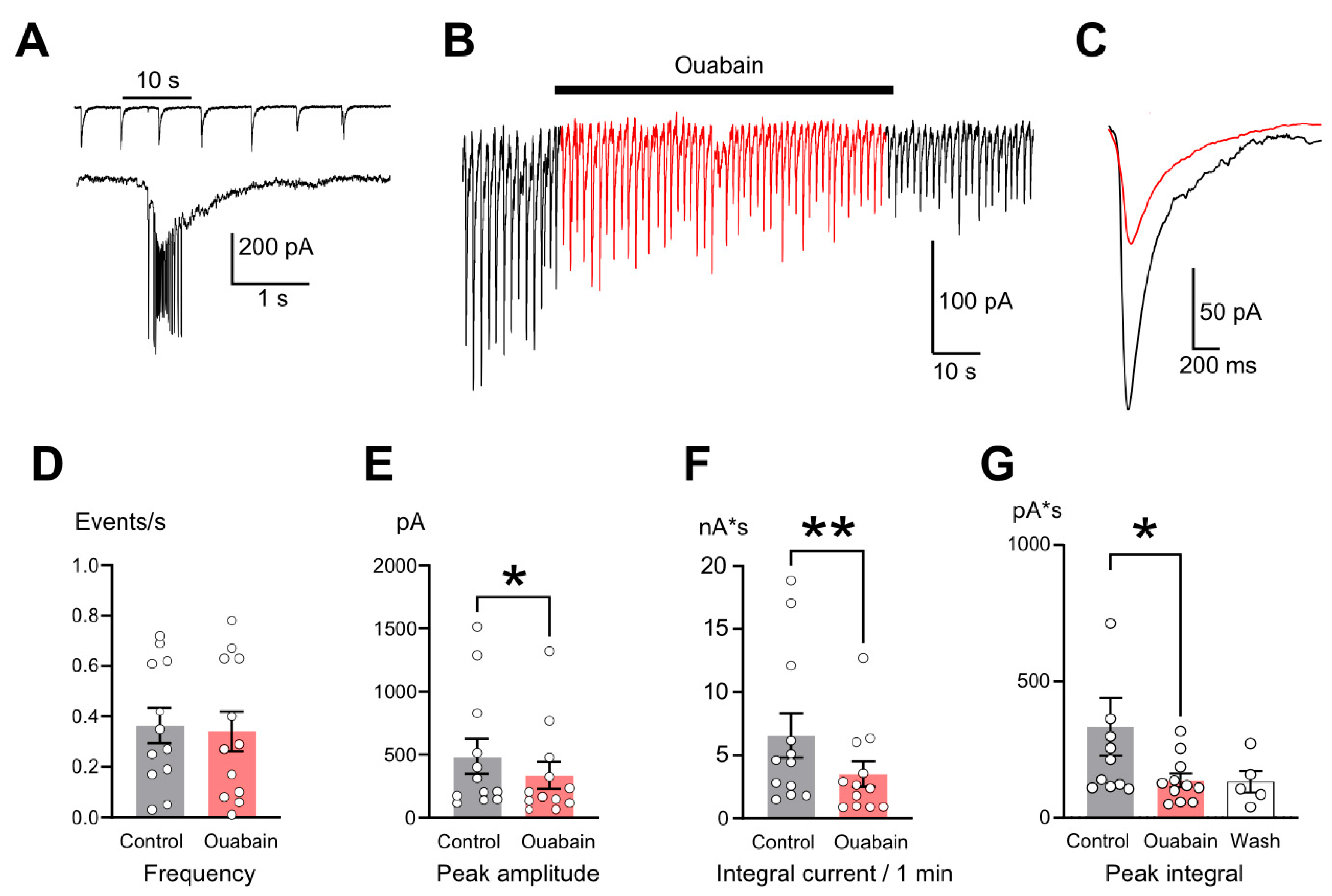
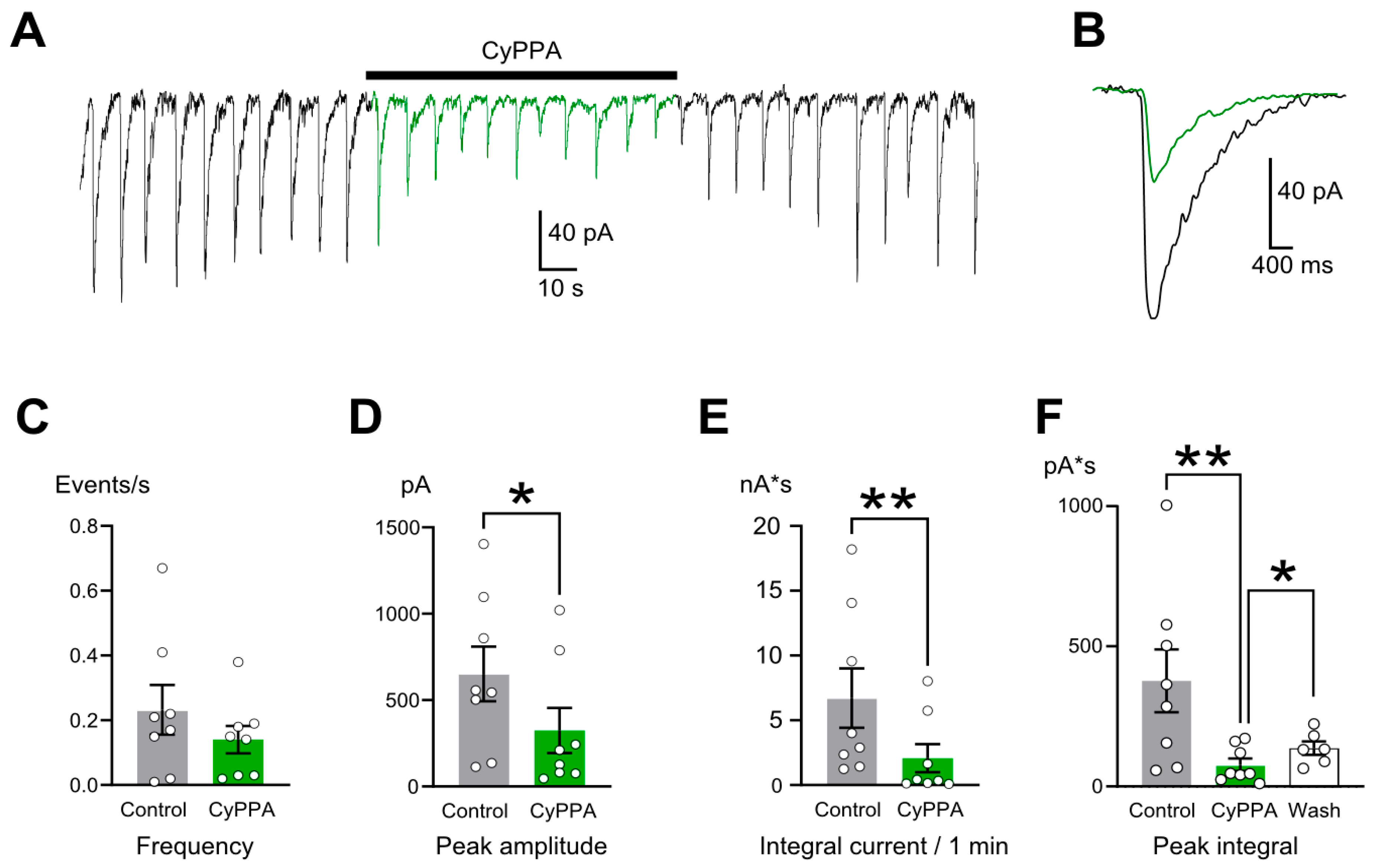
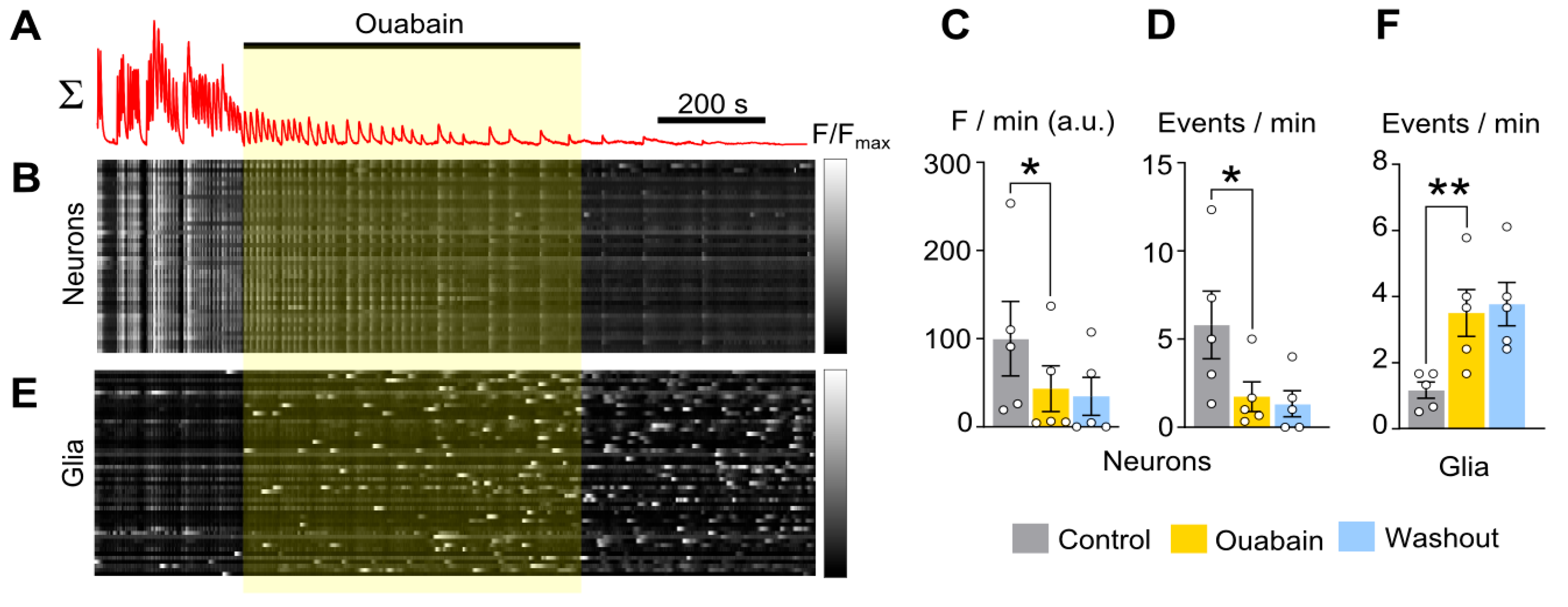
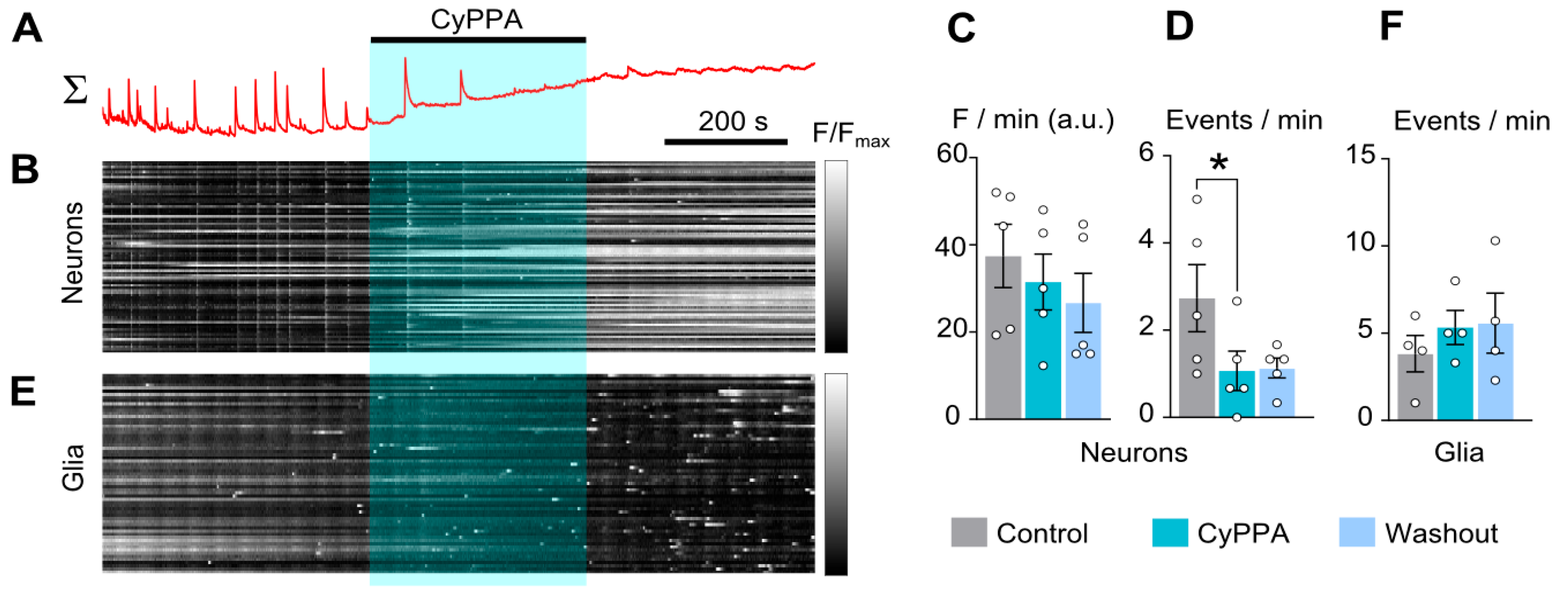

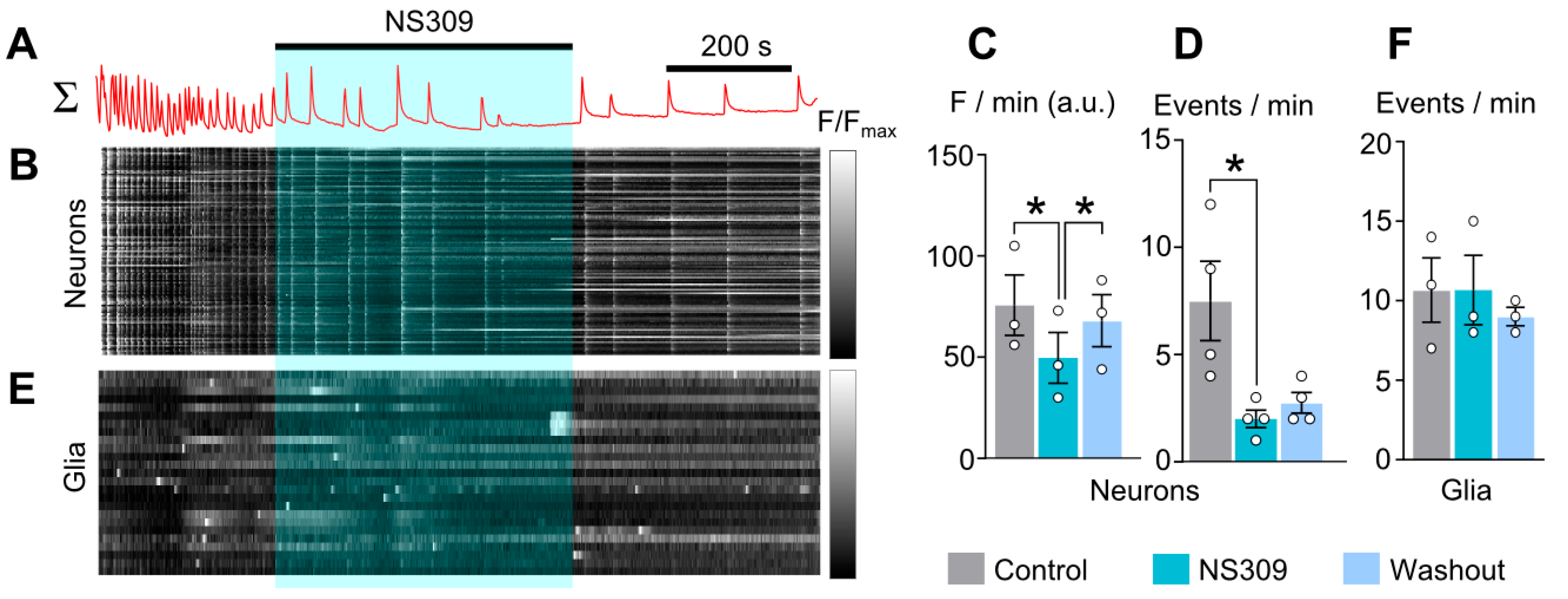
| Control | Application | Washout | |
|---|---|---|---|
| Ouabain | 333 ± 102 (n = 11) | 137 ± 25 (n = 11) * | 132 ± 40 (n = 5) |
| CyPPA | 376 ± 112 (n = 8) | 77 ± 22 (n = 8) ** | 136 ± 23 (n = 6) # |
| Intensity/Min | Events/Min | |||||
|---|---|---|---|---|---|---|
| Control | Application | Washout | Control | Application | Washout | |
| Ouabain 1 nM | 100 ± 42 (n = 5) | 43 ± 26 (n = 5) * | 34 ± 21 (n = 5) | 5.8 ± 1.9 (n = 5) | 1.7 ± 0.8 (n = 5) * | 1.3 ± 0.7 (n = 5) |
| CyPPA 10 µM | 37 ± 7.2 (n = 5) | 31 ± 6.4 (n = 5) | 27 ± 6.7 (n = 5) | 2.7 ± 0.8 (n = 5) | 1.0 ± 0.45 (n = 5) * | 1.1 ± 0.2 (n = 5) |
| CyPPA 10 µM + Ouabain 1 nM | 103 ± 22 (n = 3) | 57 ± 13 (n = 3) * | 5.6 ± 1.4 (n = 3) | 1.0 ± 0.5 (n = 3) * | ||
| NS309 10 µM | 76 ± 15 (n = 3) | 50 ± 13 (n = 3) * | 68 ± 13 (n = 3) # | 8.3 ± 2.3 (n = 4) | 2.0 ± 0.5 (n = 4) * | 3.0 ± 0.6 (n = 4) |
Disclaimer/Publisher’s Note: The statements, opinions and data contained in all publications are solely those of the individual author(s) and contributor(s) and not of MDPI and/or the editor(s). MDPI and/or the editor(s) disclaim responsibility for any injury to people or property resulting from any ideas, methods, instructions or products referred to in the content. |
© 2025 by the authors. Licensee MDPI, Basel, Switzerland. This article is an open access article distributed under the terms and conditions of the Creative Commons Attribution (CC BY) license (https://creativecommons.org/licenses/by/4.0/).
Share and Cite
Sibarov, D.A.; Boikov, S.I.; Karelina, T.V.; Yushko, V.V.; Fedorina, A.I.; Antonov, S.M. Comparative Study on Modulation of Synchronized Neuronal Activity by SK Channels and Na/K-ATPase. Int. J. Mol. Sci. 2025, 26, 10004. https://doi.org/10.3390/ijms262010004
Sibarov DA, Boikov SI, Karelina TV, Yushko VV, Fedorina AI, Antonov SM. Comparative Study on Modulation of Synchronized Neuronal Activity by SK Channels and Na/K-ATPase. International Journal of Molecular Sciences. 2025; 26(20):10004. https://doi.org/10.3390/ijms262010004
Chicago/Turabian StyleSibarov, Dmitry A., Sergei I. Boikov, Tatiana V. Karelina, Vadim V. Yushko, Alyona I. Fedorina, and Sergei M. Antonov. 2025. "Comparative Study on Modulation of Synchronized Neuronal Activity by SK Channels and Na/K-ATPase" International Journal of Molecular Sciences 26, no. 20: 10004. https://doi.org/10.3390/ijms262010004
APA StyleSibarov, D. A., Boikov, S. I., Karelina, T. V., Yushko, V. V., Fedorina, A. I., & Antonov, S. M. (2025). Comparative Study on Modulation of Synchronized Neuronal Activity by SK Channels and Na/K-ATPase. International Journal of Molecular Sciences, 26(20), 10004. https://doi.org/10.3390/ijms262010004







